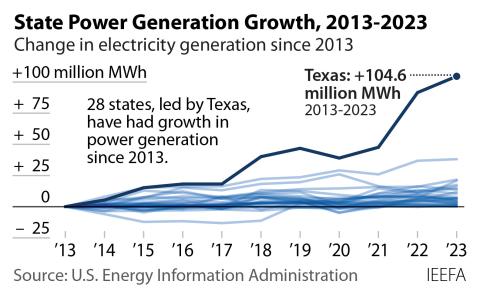IEEFA Cleveland: The Lights Are on but the Bills Are Too Damn High
It’s been a remarkably eventful summer to be a Clevelander—from the joyous celebration of more than a million people at the Cleveland Cavaliers’ NBA victory parade in June to the who-knows-what-to-expect Republican National Convention events in the city this week.
Cleveland did a lot of sprucing up to get ready for the RNC, including renovations at the centerpiece Public Square downtown, where a place of honor is given to an early 20th-century Cleveland mayor, Tom L. Johnson. A refurbished statue shows Johnson gazing benevolently over the city he was so influential in shaping, from the architecture and layout of major public buildings to the creation of a municipally-owned public electric system.
Here’s the mayor on how utility companies ought to be run:
“I believe in municipal ownership of all public service monopolies… because if you do not own them, they will in time own you, they will rule your politics, corrupt your institutions and finally destroy your liberties.”
The utility that Johnson created, Cleveland Public Power, still exists. And Cleveland has a situation unique among all major U.S. cities by which the city-owned electric utility competes house-to-house for customers with the privately owned utility, FirstEnergy, in neighborhoods where they both do business.
This competition has been fraught with intrigue, legal battles, and political strife for a century. Tensions came to a head in the 1970s, when customers of Cleveland Public Power (then known as Muni Light), paid electric rates that were 20 percent lower than those charged by Cleveland Electric Illuminating Company, or CEI, which eventually became a subsidiary of FirstEnergy. This was a situation Mayor Johnson had foreseen—a city-owned utility charging lower rates because it was a non-profit company that didn’t have to reap profits for shareholders.
CEI wanted the public-power customers, and showed it would stop at almost nothing to get them. The private utility, as eventually revealed in an antitrust review conducted by the Nuclear Regulatory Commission, manipulated Cleveland’s electric system in a way that required Muni Light to pay higher prices, that blocked power purchases, and that even forced an outage during an emergency to make Muni Light look unreliable.
These tactics succeeded for a time, and the private company scared politicians into agreeing to sell the public utility to the private one. Thankfully the transaction was killed after Dennis Kucinich became mayor in 1976. CEI and its banker allies pushed the city to the brink of default in a showdown over this issue in 1978, but Kucinich stood firm. In a February 1979 referendum, voters decided to preserve Muni Light by making it untouchable to private interests.
The ghost of Mayor Johnson had prevailed.
Today, unfortunately, the mayor is probably spinning in his grave. Cleveland’s electricity market has degenerated into exactly what he had hoped to avoid. Neither the private utility–FirstEnergy–nor the public utility–Cleveland Public Power –is serving the public interest. Residential electricity prices from both are almost identical, and customers have no way of getting a better deal.
On the private utility side, as IEEFA has documented in a series of reports, FirstEnergy has made a string of corporate decisions to keep rates high, even after Ohio deregulated electricity in 2000 in hopes of encouraging competition. FirstEnergy sought and received a $6.9 billion bailout, approved by the state legislature, requiring customers to pay for cost overruns at its nuclear plants. And then, in 2011, it purchased Allegheny Power, a doubling down on coal-fired power just as coal was becoming a terrible investment. FirstEnergy is now seeking a $4 billion customer bailout from the Public Utilities Commission of Ohio to keep its struggling coal plants afloat.
On the public utility side, Cleveland Public Power, or CPP, has made bad decision after bad decision over the past decade. The utility entered into a set of long-term, “take-or-pay” contracts with American Municipal Power (AMP) for very expensive projects at a time when simply paying market prices would have been far better. CPP is now locked into a 50-year contract to support the faltering Prairie State coal plant, which came in $1 billion over budget and has had ongoing technical problems. It also bought into long-term deals for new hydropower plants that turned out twice as expensive as promised.
Electricity market prices around the country, and in Ohio, are as low as they have been in decades, but you wouldn’t know it from what either Cleveland utility charges. Our city, which was the epicenter of the national home-foreclosure crisis in 2008, is still struggling to rebuild.
Our households and business would benefit hugely from a utility regime that charged reasonable rates. That can happen in the long term, but it depends on whether the Public Utilities Commission of Ohio will allow FirstEnergy’s ratepayer-subsidized bailout requests, whether Cleveland City Hall leaders will honor the spirit of Mayor Johnson by taking assertive action to protect public-utility ratepayers, and whether Cleveland Public Power and Cleveland Electric Illuminating Company will join the 21st century and develop low-cost renewable and efficient power solutions for the future.
Sandy Buchanan is IEEFA’s executive director.
RELATED POSTS:
Ohio Ratepayers Get Short Shrift in State’s Refusal to Embrace Renewables and Efficiency Programs
Groundswell in Ohio Against FirstEnergy and AEP Bailouts (With More to Come)
The Truth About Prairie State Energy Campus (Part 1): Failing, Year by Year











